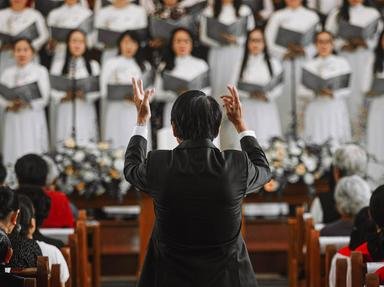Quiz Answer Key and Fun Facts
1. In Britain, the twentieth century began with a degree of backlash against many hymns and tunes of the Victorian era. It was characterised by publication of the "English Hymnal" in 1906. This collection was edited by Percy Dearmer, who worked alongside which composer to provide traditional folk tunes for many hymns?
2. "Joyful, Joyful, We Adore Thee" is one of the most popular twentieth century American hymns. It was written in 1907 by Henry Van Dyke to the melody of which piece of classical music?
3. The Social Gospel Movement had a strong influence on many early twentieth century hymns. One of its most enduring compositions has been "God of Grace and God of Glory", written in 1930 by Harry Fosdick. In that same year, Fosdick's prominence led to his appearing on the cover of which of these magazines?
4. There can't be many hymn writers that can put an Oscar-winning movie on their CV. Joyce Maxtone-Graham wrote hymns such as "Lord of All Hopefulness" and "When a Knight Won His Spurs" under the pseudonym of Jan Struther. She also wrote a column for the "Times" newspaper that formed the inspiration for which of these movies?
5. The second half of the twentieth century saw a massive explosion in the writing of hymns and worship songs. Which of the following had a profound effect on the writing of such material?
6. Just as the early years of twentieth century England had seen the use of traditional folk songs as hymn tunes, the post-Second World War years in America saw the recovery of many folk tunes from the Spiritual and Shape note traditions. What is the name of the most prominent book to contain music for Shape note singing?
7. Brian Wren had been one of the most prominent of twentieth century hymn writers. The hymn "Christ is Alive! Let Christians Sing" was written for Easter 1968, in response to which of these tragedies?
8. Another popular twentieth century hymn has been "Make Me a Channel of Your Peace". This was written by Catholic hymn writer Sebastian Temple, based upon a prayer attributed to which of these saints?
9. The twentieth century saw a much greater awareness of hymns from around the world. Which of these hymns was written in Swedish and translated through three further languages before being popularised by the work of Billy Graham in the 1950s and '60s?
10. Of all the hymns written in the early twenty-first century, "In Christ Alone" has made an immediate worldwide impact. It was written by Irish composer Keith Getty, with words by Stuart Townend. It was first published in 2001 as part of a project with which of these titles?
Source: Author
glendathecat
This quiz was reviewed by FunTrivia editor
Pagiedamon before going online.
Any errors found in FunTrivia content are routinely corrected through our feedback system.
